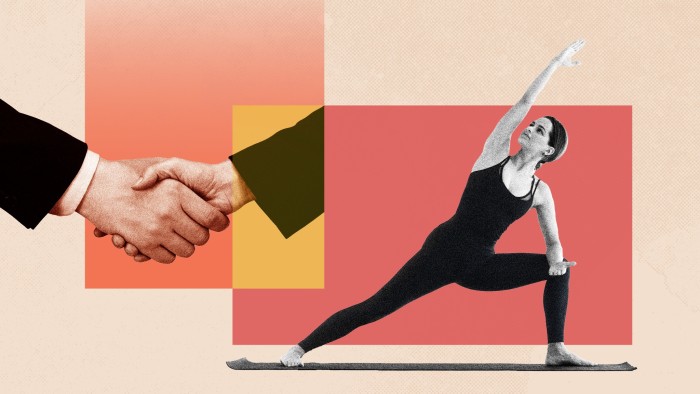“Sweat equity takes on a whole new meaning when you’re networking in a hot room,” says Chad Messer, a managing director at US lender KeyBanc. Rather than a bustling conference, he is referring to hot yoga, a practice done in temperatures of 35C to 40C.
Messer does sessions before work, typically at 5.30am. “It is a great way to start the day,” he says. As well as “physically challenging”, he finds it “mentally grounding”.
He is part of a growing trend to incorporate hot yoga into the working day. Instructors say individuals are enjoying it as a welcome break from thinking about work, while some teams are swapping a group lunch or dinner to take sessions together.
Over the past few years, Kelly Isaac, instructor and co-owner of ID Hot Yoga, which operates studios in New York and the Hamptons, has seen a growing number of executives, particularly men, practising before work. “It’s an hour they choose for themselves, when they are shutting everyone else out,” she says. “You can go for a run, or Barry’s [boutique fitness studios] but yoga gets you into your flow state when you’re not thinking about the email you need to send.”
Sophie Deakin, a teacher at Hot Yoga Shoreditch, on the edge of the City of London, identifies a broader workplace trend. “There’s a cultural shift [to] doing these activities in a business,” she says. She has a regular group from a bank and another from a pharmaceutical company and her studio also offers corporate sessions for team building. It has a branch in Canary Wharf, home to many global banks. Clients “are high-fiving each other after”, Deakin says. “There’s a lot of camaraderie with people and the recognition that it’s challenging.”
Hot yoga was popularised by Bikram Choudhury, who later tried unsuccessfully to copyright it, and also faced sexual harassment allegations. More recently, social media influencers have brought it to younger audiences.
Deakin notes a change in motivation among the busy professionals who come to her studio. “People used to do it because they thought they’d get really skinny really quick, or want the challenge.” Now more customers want to improve their wellbeing, she says.
Becca Gray, a town planner based in Manchester who organised a session at a property event for young women recently, says despite initial nerves, attendees reported feeling in “a better mind state to network openly and effectively” after yoga. “They felt so relaxed yet energised . . . Trying something new together gives people an opportunity to connect over shared experience.”
Another enthusiast, LeeAnn Black, chief operating officer at Latham & Watkins law firm, finds it helps clear her mind. “Being in a hot studio requires a lot of determination. It’s hard. You really have to concentrate. I really forget about work for an hour. I walk into that hot room and the [stress] temperature goes down. It’s super helpful.” In other activities, such as SoulCycle, she finds her mind wanders. “The intensity of hot yoga allows you to get into a place of relaxation while at the same time it’s rigorous. You put your phone away, you can’t have a phone in the room.”
Beth McGroarty, research director at the Global Wellness Institute, says hot yoga is part of an evolving corporate trend replacing “the old company nights eating and guzzling booze with healthier social and evening experiences”. With the rise of sober workers, companies are “respecting that choice and alternative non-boozy group outings might become more the norm”.
Similarly, in conferences, she says, “it feels almost de rigueur now to programme in wellness — whether yoga, breath work, meditation, fitness, group running sessions — [to] the agenda”.
Philip Berlinski, co-chief operating officer of the Millennium hedge fund, notes a “huge shift” since he started in financial services in 1998. “The culture’s changed. There’s greater mental health awareness, more focus on wellbeing, and it’s less male-dominated now . . . People realise they are working longer and need to think about their health more.”
He did his first hot yoga class two and a half years ago, describing it as “the worst one-hour experience I’d had in a while. I was a ball of sweat. It was exhausting. But it felt good. It’s difficult to be in your mind, you’re focusing on your breathing. [It] stops me thinking, improves my flexibility.”
Isaac observes that for executives new to the practise, “the head gets in the way. You get guys come in [who] can run a marathon, or [are] physically strong, and they can’t touch their toes, or stand in stillness. It’s a physical challenge as well as a mental challenge.”
One randomised control study found that “16 weeks of Bikram yoga significantly improved perceived stress, general self-efficacy and [health-related quality of life] in sedentary, stressed adults”.
There are also professional benefits. Sometimes Messer encounters bank colleagues at sessions, providing an opportunity “to connect with people at different levels”.
It is a striking shift from the old ways of networking. “A lot of professionals prefer early morning yoga [over] evening events,” he says. “It’s healthier. You start your day earlier but you finish it earlier. Black occasionally takes a class with colleagues, “in lieu of a meeting, we’ll walk over together and then go for dinner”.
It offers a more convivial, and perhaps lower stakes, approach compared with other sports, says Berlinski. “Golf is competitive. You’re not competing with anyone with hot yoga.”
